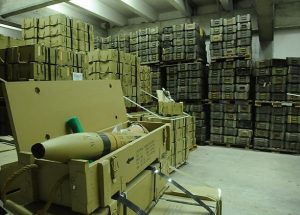By Dr. Ehud Eilam
EXECUTIVE SUMMARY: Ever since the 2006 war, Israel has preferred to contain Hezbollah rather than fight it directly. So determined was Israel to avoid going to war with the terrorist group that it tolerated its significant military buildup. Since 2012, however, the IAF has carried out hundreds of sorties inside Syria aimed at stopping the delivery of advanced weapons to Hezbollah. Israel can continue to delay the arming of Hezbollah, but it has already become quite strong, and a war could occur even if neither side wants it.
Tensions between Israel and Iran’s Lebanese proxy, Hezbollah, have reached the point where war might well ensue. Neither side wants this, at least not right now, but it could still occur, either as a result of miscalculations and or of a rapid escalation that got out of control.
The two sides confronted each other in Lebanon in the 1980s and 1990s, and their 34-day war in the summer of 2006 ended in a tie. According to the IDF’s strategy document of 2018, the next time Israel and Hezbollah go to war, the IDF will be eager to strike the group hard in order to achieve a fast victory.
This will not be easy. Hezbollah does not have a clear center of gravity that can be wiped out and thereby bring Israel a quick and clear victory. The organization also enjoys vast support from the Shiite community in Lebanon.
The IDF has many more weapons and much more manpower than Hezbollah—but Hezbollah has up to 150,000 projectiles aimed at Israel. All of Israel is within Hezbollah’s missile range, but it would primarily target the north of the country. The sheer quantity of rockets available to Hezbollah means that Israel’s defense systems such as the Iron Dome would only be able to intercept some of them. The only way to completely stop the firing of missiles and rockets would be to run a large-scale offensive inside Lebanon.
The IAF has been training to launch thousands of sorties aimed at destroying Hezbollah targets, mainly its rockets. But the IAF might not be able to accomplish this mission by itself, especially if rockets hit its airfields. Israel might have no alternative but to also conduct a major ground offensive.
This would not be like 2006, when Israel hesitated and was reluctant to carry out a large-scale land attack for fear of incurring heavy casualties. In the next war the concept might be the opposite. In other words, reducing Israeli casualties, both on the front line in Lebanon and in the Israeli rear, might require starting the war with a large-scale ground attack.
Many in the IDF seek to prove that Israel is willing to carry out a ground offensive, even if its costs might be high. The concept is that Israel’s foes should not assume that Israel is afraid to put its ground units in harm’s way and will always prefer to rely on air power. In the Gaza Strip operations of 2008-09 and in 2014, Israel conducted limited ground attacks and depended on the IAF.
But Israel should not launch a ground offensive just to prove a point if conditions are not right. If there is a limited confrontation and both sides express their willingness to end it soon, then sending ground units into Lebanon could pointlessly extend the war. Starting a war with a major attack is not always the right option.
The IDF might penetrate deep into Lebanon, advancing dozens of kilometers on the ground. Israeli ground units probably will not reach Beirut as they did in 1982, but they might advance further than they did in 2006. Long-range penetrations might be carried out not with armor but with airborne assaults. Crack units such as the new 89th commando brigade (established in 2015) can land from the air. These would be risky operations as Israeli troops would be isolated far behind enemy lines, receiving help mostly from aircraft that would deliver supplies and provide fire support.
The IDF would not stay there for long. The goal would be to annihilate Hezbollah’s rockets and then withdraw. It would be like a large-scale raid, not a conquest. Israel would not go back to the 1990s, when it was entangled in an endless fight inside Lebanon that cost it dearly.
Elite units such as the 401st armored brigade would advance on the ground. The IDF would rely on Merkava Mark 3 and 4 tanks and heavy armored personal carriers (the Achzarit and the Namer, together with the old M-113). The IDF’s sophisticated C4I (Command, Control, Communications, Computers, and Intelligence) network would assist too, but the IDF should not depend on it too much in case it fails.
Senior Israeli officials have warned several times about the severe ramifications of turning Lebanon into a fire base against Israel. Hezbollah deliberately hides its rockets in urban areas. Israeli firepower, aimed at the rockets in those areas, would inevitably inflict substantial collateral damage.
If Hezbollah opens fire first, targeting Israeli cities, it will force Israel to react immediately and in a massive way. An Israeli preemptive strike is unlikely, though surprise is crucial in capturing Hezbollah off guard.
The IDF has an overwhelming edge over Hezbollah, but the latter has relative advantages, mainly its missiles/rockets. The two sides will continue to try to avoid a costly war, but a war might still occur—against the will of one or even both of them.

No comments:
Post a Comment